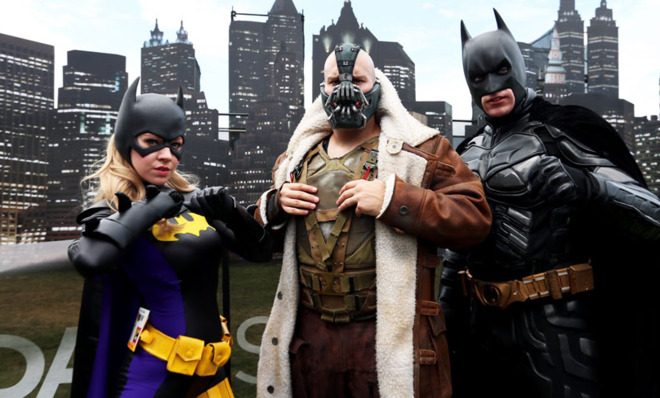Why the rise of cosplay is a bad sign for the U.S. economy
Dressing up like Wolverine or Cersei Lannister is probably more fun than scouring the classifieds for menial jobs


Imagine you're a college graduate stuck in a perpetually lousy economy. That's a problem Japanese twenty-somethings have faced for more than 20 years. Two decades of stagnation after the collapse of the 1980s real-estate and stock bubbles — combined with labor laws making it tough to fire older workers — have relegated vast numbers of Japanese young adults to low-paying, temporary contract jobs. Many find themselves living with their parents well into their twenties and beyond, unmarried and childless.
Then again, they do have plenty of time to dress up like wand-wielding sailor girls and cybernetic alchemist soldiers from the colorful world of anime cartoons and manga comics. Indeed, Japan's Lost Decades have coincided with a major spike in "people escaping to virtual worlds of games, animation, and costume play," Masahiro Yamada, a sociology professor at Chuo University in Tokyo, recently told the Financial Times. "Here, even the young and poor can feel as though they are a hero."
It's hard to blame them. After all, it's not that these young adults in Japan are resisting becoming productive members of the economy — it's that there just aren't enough opportunities for them. So an increasingly large number of them spend an increasingly large amount of time living in make-believe fantasy worlds, pretending they are someone else, somewhere else. This is a very bad thing for the Japanese economy.
The Week
Escape your echo chamber. Get the facts behind the news, plus analysis from multiple perspectives.

Sign up for The Week's Free Newsletters
From our morning news briefing to a weekly Good News Newsletter, get the best of The Week delivered directly to your inbox.
From our morning news briefing to a weekly Good News Newsletter, get the best of The Week delivered directly to your inbox.
And guess what: America has a growing number of make-believe "cosplay" heroes, too. Many of the 130,000 people who attend the San Diego Comic Con every year invest big bucks in elaborate outfits as a way of showing off their favorite Japanese characters, as well as those from American superhero movies, comics, and "genre" televisions shows such as Game of Thrones. And this trend is growing — the crowd at Comic Con was one-third this size in 2000. In 2013, the SyFy channel even created a reality show about the trend, Heroes of Cosplay.
The rise in popularity partly stems from the 1990s influx of Japanese anime and manga. But America's own post-bubble economic funk is also probably playing a role. U.S. economic growth has averaged just 1 percent annually since 2006, as the Great Recession has been followed by a weak recovery. And that anemic growth has dimmed prospects for young job seekers. The unemployment rate for men and women 20 to 24 years old is 11.4 percent, versus a low of 7.2 percent in 2007. And as a new White House report notes, workers who get their first jobs during a recession earn as much as 9 percent less per year than those who do not — and the effect lasts for as much as 15 years.
When you're disillusioned with the reality of your early adult life, dressing up like Doctor Who starts looking better and better. It's not to say that all or even most cosplay aficionados are struggling to find work. It's only to say that any rise in people fleeing reality for fantasy suggests problems with our reality.
What's more, the Federal Reserve Bank of New York finds that the underemployment rate for recent college grads — the share working in jobs that typically don't require a college degree — is 46 percent, versus 36 percent for grads in general. And as in Japan, more young adults are living with their parents than before the bubble burst. The New York Times calls this group "Generation Limbo." They are highly educated young adults "whose careers are stuck in neutral, coping with dead-end jobs and listless prospects."
A free daily email with the biggest news stories of the day – and the best features from TheWeek.com
And perhaps in limbo they will stay, at least without major policy changes in Washington. This isn't just a Great Recession thing. Economic growth has been historically slow since 2000, with the economy producing more high- and low-wage jobs than middle-wage jobs — what economists call "job polarization." Accelerating automation may create an even more lopsided labor market in the future, where only a tech-savvy sliver see rising wages from steady gigs. For everyone else, service jobs — often irregular — with little or no wage growth. Baristas and bartenders with Bachelors degrees — just what Mom always dreamed of for you.
Now, this is a future of what might be, not what must be. A U.S. economy with fewer barriers to startups, modernized infrastructure, and a better educated workforce could be more dynamic and prosperous for everybody. But that's not where we're heading.
Perhaps that's tolerable, if not ideal. As economist Tyler Cowen has put it, "Think of 85-80 percent [of workers] as human-capital bohemians who don't necessarily have great jobs but do interesting things." Like using Yelp to find tasty-but-cheap eats. Or spending hours social networking. And, of course, engaging in cosplay mimicry — thanks to an economy that unfortunately is itself looking more and more like something the Japanese know all too well.
James Pethokoukis is the DeWitt Wallace Fellow at the American Enterprise Institute where he runs the AEIdeas blog. He has also written for The New York Times, National Review, Commentary, The Weekly Standard, and other places.
-
 Political cartoons for January 17
Political cartoons for January 17Cartoons Saturday’s political cartoons include hard hats, compliance, and more
-
 Ultimate pasta alla Norma
Ultimate pasta alla NormaThe Week Recommends White miso and eggplant enrich the flavour of this classic pasta dish
-
 Death in Minneapolis: a shooting dividing the US
Death in Minneapolis: a shooting dividing the USIn the Spotlight Federal response to Renee Good’s shooting suggest priority is ‘vilifying Trump’s perceived enemies rather than informing the public’
